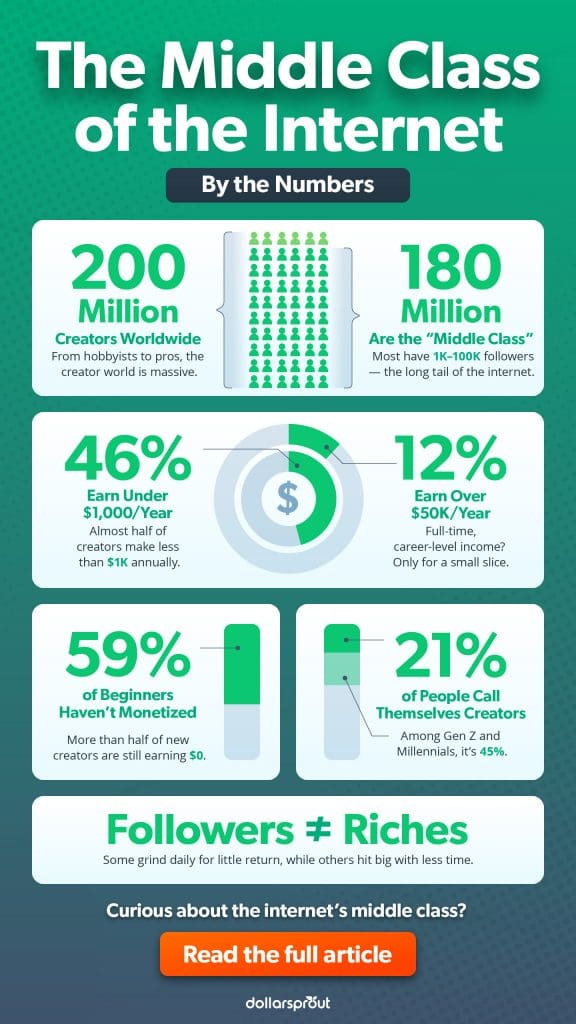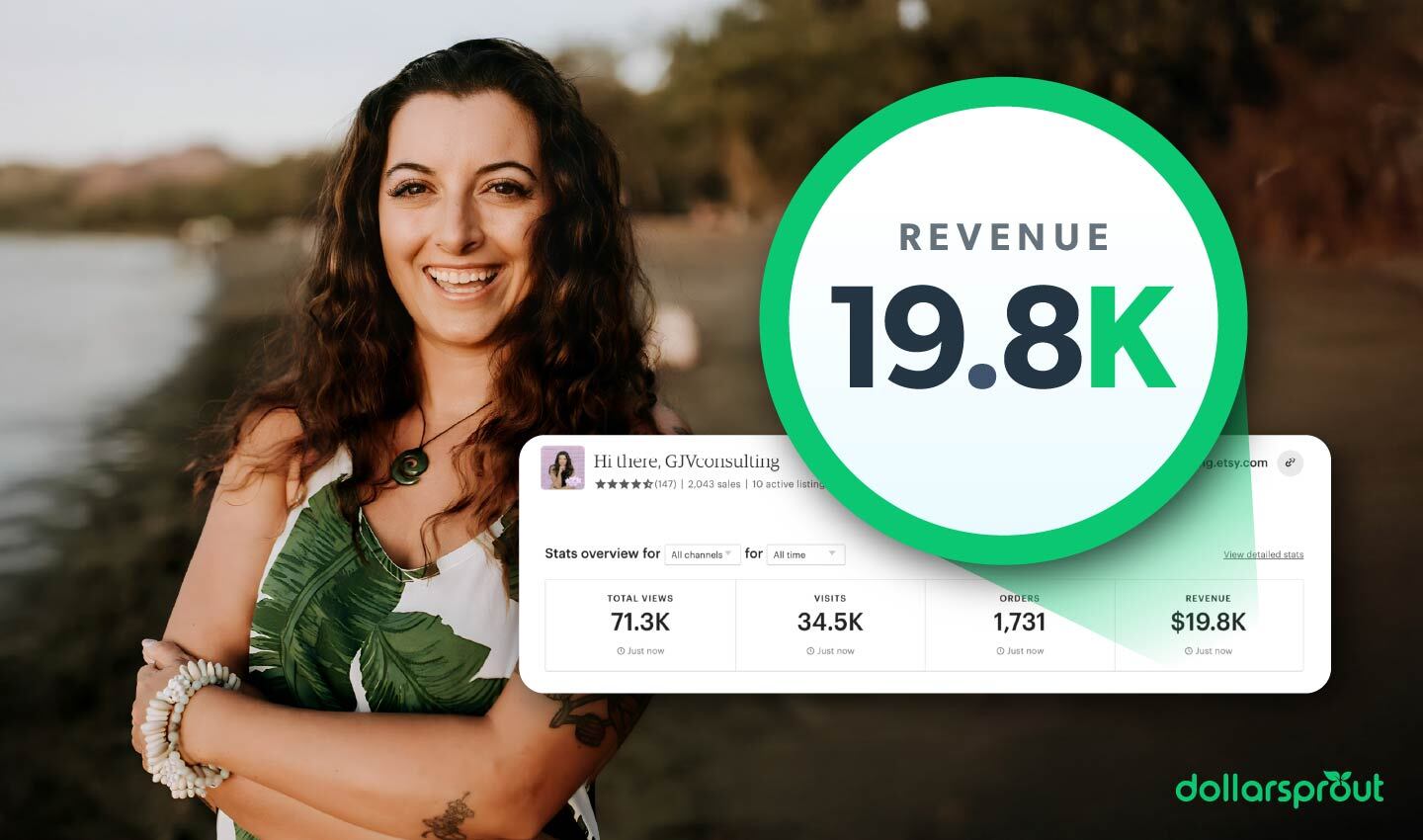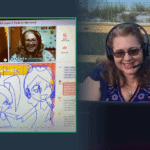Everyone’s a Creator Now — But the Middle Class Still Gets Ignored
The internet’s middle class keeps showing up — and keeps getting overlooked. Here’s why they matter more than ever.

Every platform has its stars. The million-subscriber YouTuber. The podcast host with a book deal. The TikTok creator who quits their job after one viral video.
But scroll past the headlines and you’ll find a different kind of creator.
A woman with 15,000 subscribers who’s been posting tutorials for years and still earns just $300 a month. A digital artist selling printable planners on Etsy. A part-time UGC creator who lands two brand deals a quarter and uses the extra income to help cover daycare.
They don’t have merch lines or viral fame. They’re not building empires. But they’ve built something else — a middle ground.
This is the internet’s working class. Creators who are visible, valuable, and largely left out of the story.
The Hidden Majority of the Creator Economy
Many platforms and news outlets focus on top influencers, which makes it seem like a creator has to be a celebrity to matter. But that’s not true.
A massive middle class exists within the creator economy — millions of people who post consistently, earn modest income, and treat their work with professionalism, even if it’s not their full-time job. According to Linktree’s 2022 Creator Report, around 180 million creators fall into this group. Most have between 1,000 and 100,000 followers and bring in $250 to $3,000 a month from content, services, products, or affiliate work.[1]
They produce much of the internet’s useful, searchable content. Fan fiction forums, digital art tutorials, niche blogs that answer the exact question you just Googled — these often come from creators in the middle.
Further undercutting the binary narrative: only 12 percent of full-time creators earn more than $50,000 a year. Nearly half earn less than $1,000. Those numbers haven’t changed much. Algorithms tend to reward what’s already performing, which makes it hard for consistent, slower-growing creators to break through.
The middle class of the internet might not grab headlines, but they shape more of online culture than most people realize.
Related: How This Couple Makes $1,000 a Month Cooking on TikTok
Why the Middle Feels Invisible
Mid-tier creators often sit in an awkward spot. Too established to feel like beginners, too small to be considered stars.
Platforms tend to amplify extremes. Their algorithms push content from the top 1 percent — the creators with momentum, media coverage, and massive engagement. At the same time, they boost newcomers in hopes of finding the next breakout. Everyone else struggles to stay visible.
Brands do something similar. Many chase high-profile names with big reach, or they flood entry-level creators with discount codes and giveaways. There’s little infrastructure for supporting creators in the middle, even if their audiences are more engaged and their work more sustainable.
Culturally, the middle doesn’t make a good headline. Modest success rarely goes viral. There’s no hook in “steady growth over three years.” And so the middle class of the internet often gets overlooked, even as it creates much of the content that fills our search results, feeds, and inboxes.
Their success just looks quieter. Which makes it easy to ignore.
Related: She Took the Scenic Route — Now Her Travel Blog Makes $2K/Month
The Invisible Ceiling: Why Breaking Through Is Harder Than It Looks
For many creators in the middle, growth eventually slows. They’ve built something real, but they’ve hit a wall.
Online success often starts with momentum — maybe a few popular videos, a breakout product, or a small but loyal following. But turning that into long-term income takes more than consistency. It takes systems. It takes business skills. It takes time most people don’t have.
The platforms don’t teach creators how to build that next layer. There’s no onboarding for pricing digital products, optimizing for search, or managing a content calendar without burning out. These are learned slowly, if at all.
Meanwhile, the creators at the top often have help. They outsource editing, hire managers, run ads, or reinvest aggressively to stay visible. That kind of support is out of reach for most in the middle.
It’s not a lack of effort. It’s a lack of scaffolding.
Related: How Emily Odio-Sutton Built a $560K Print-on-Demand Business
Why Many Creators Choose to Stay Small
Some middle-class creators aren’t stuck. They’re exactly where they want to be.
Think of a blogger with 25,000 monthly pageviews who just wants to help with the family budget, without going back to a 9-to-5. Or a college student who covers textbooks by podcasting on weekends. They’re not chasing fame or a million-dollar exit. They’re creating something sustainable — and that’s enough.
Plenty of smaller creators have no desire to build an empire. Maybe their audience growth has slowed or even plateaued. That works for them. They’ve built a community that shows up and cares, which means more to them than playing algorithm games.
Quiet success rarely makes headlines. But in the creator world, it may be the most stable path forward.
Burnout is everywhere. A recent study from Billion Dollar Boy found that 52% of influencers report feeling burnt out. Over a third have considered quitting entirely. Even creators at the top feel the strain.[2] As Mr. Beast said on The Diary of a CEO podcast, “If my mental health was a priority, I wouldn’t be as successful as I am.”
That kind of pressure has led many creators to rethink what they want. Fewer are chasing virality. More are choosing balance.
Kinsey Grant, co-founder of Smooth Media, has seen the shift firsthand. She helps creators with monetization and operations, and even launched her own YouTube channel. For her, the goal was community — not stardom.
“There is room to carve out a career that fits your life, that fits your needs, that fits your lifestyle without becoming these giant names that have blown up,” Grant told The Washington Post. “In this ‘middle class of the creator economy’ route, I can do what I want to do.”
The Middle Is the Point
The internet’s middle class doesn’t chase trends or hack virality. They answer questions in niche forums, post how-to videos that actually teach something, and write blogs that read more like personal journals than traffic bait.
It’s the kind of content you find when you’re looking for help — not entertainment.
They publish regularly, build trust over time, and quietly shape the digital culture most of us actually live in.
Their work also supports a different kind of economy. Some earn enough to skip a second job. Others use the extra income to stay home with their kids, take fewer shifts, or fund a creative habit. It’s modest. It’s flexible. And for a lot of people, that’s the dream.
But platforms don’t reward that kind of success. Brands chase reach. Media celebrates extremes. And in between, thousands of creators keep showing up anyway.
Maybe “making it” doesn’t need to mean millions of followers. Maybe it just means enough.
Related:
- How One Woman Earns $300/Mo Promoting Brands on Social Media
- Why Weird Side Hustles Often Make Great Money — And How to Find One
- 19 Flexible Stay-At-Home Jobs for Moms That Pay Well









